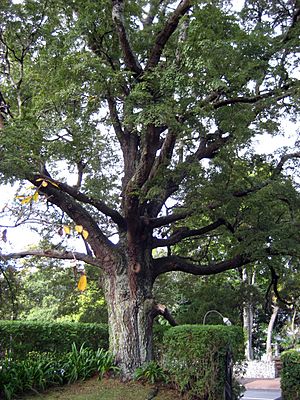Black beech facts for kids
Quick facts for kids Black beech |
|
|---|---|
 |
|
| Scientific classification | |
| Genus: |
Nothofagus
|
| Species: |
solandri
|
| Synonyms | |
|
Fuscospora solandri (Hook.f.) Heenan & Smissen |
|
The Black beech (Nothofagus solandri var. solandri) is a special type of tree found only in New Zealand. It grows on both the North and the South Island, from low areas up into the mountains. It is a variety of the Nothofagus solandri species. Another variety, called Mountain beech, grows at higher altitudes. In New Zealand, this tree is also known as Fuscospora solandri.
Black beech trees are medium-sized evergreen trees. This means they stay green all year round. They can grow up to 27 meters (about 88 feet) tall. Their leaves are small, about 10 mm long and 5 mm wide. They are oval-shaped and have smooth edges.
Contents
What Makes the Black Beech Black?
Black beech trees get their name because their trunks and branches often look black. This black color comes from a special type of mold called sooty mold.
The sooty mold grows because of tiny insects called scale insects. These insects live on the tree and suck out its sap, which is like the tree's blood. As they feed, they excrete a sweet, sticky liquid called honeydew. This honeydew forms small droplets on the tree.
The honeydew is a perfect food source for the sooty mold, causing it to grow and cover the tree. But it's not just mold that likes the honeydew! Many birds and insects, like the kaka parrot, also love to eat this sweet liquid. It gives them a lot of energy. Even though the sooty mold covers the tree, it usually does not harm the Black beech.
Where Does Black Beech Grow?
Black beech trees are found only in New Zealand. They grow in many different places, from low-lying areas to mountain slopes.
Sometimes, Black beech trees are planted in other countries, like Great Britain. Scientists have observed that the Mountain beech, which is a close relative, seems to handle cold weather better than the Black beech in places like Scotland.
Black Beech Hybrids
Sometimes, different types of beech trees can mix their genes. This creates new kinds of trees called hybrids.
- Black beech often mixes with Mountain beech where they grow near each other. This can create many different hybrid trees.
- Black beech can also mix with hard beech. When they do, they form a hybrid tree known as Nothofagus ×apiculata.
- Another hybrid happens when Black beech mixes with red beech. This creates a hybrid tree called Nothofagus ×dubia.
See also
 In Spanish: Haya negra de Nueva Zelanda para niños
In Spanish: Haya negra de Nueva Zelanda para niños

